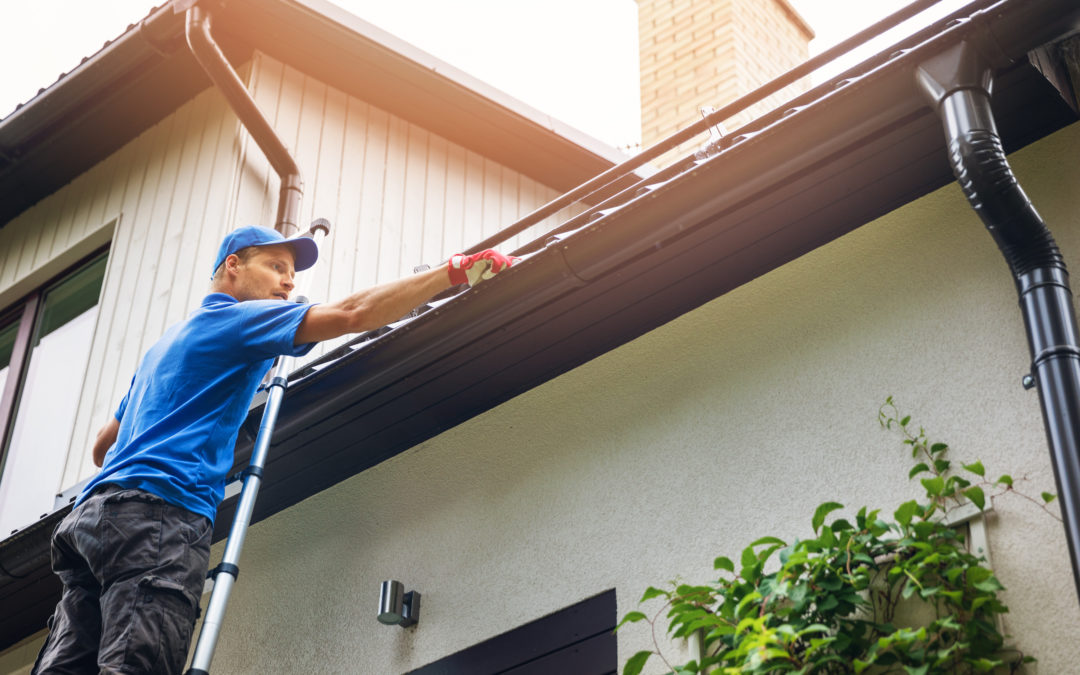Gutters are a part of your home that you probably don’t think about often—especially if they’re installed correctly and doing the job they’re meant to do. But, if you need to replace your gutters, they’ve probably been on your mind, and you might not know where to begin.
You might be surprised to discover that not all gutters are the same size. Coincidentally, choosing the right-sized gutter is the best place to start when purchasing new gutters, so we’ll tell you about standard gutter sizes, wider options, and how to pick the proper selection for your home. We’ll also explore factors like roof size and pitch, climate, and architectural design—all of which play a role in getting the most out of your gutter system.
What is the Standard Size Gutter?
The standard residential gutter size is 5 inches. This size is generally suitable for average-sized homes with moderate roof pitches and typical rainfall. These gutters offer a good balance of affordability and capacity.
Aside from standard gutter sizes, homeowners can also opt for 6-inch wider gutters, which cost more upfront but offer greater protection, especially in areas with heavy rainfall or steep rooflines. These wider gutters hold significantly more water—up to 40-50% more than 5-inch gutters—and are less prone to clogging, especially when paired with larger downspouts.
For reference:
- 5-inch gutters are 3 ½ inches deep
- 6-inch gutters are 3 ¾ inches deep
Comparing 5-inch Gutters vs. 6-inch Gutters: How to Choose
In most cases, 5-inch gutters will best serve a home. If you’re wondering if your home will benefit from 6-inch gutters, there are a few factors to consider:
- The Square Footage of Your Roof: Larger roofs shed more water. A bigger roof surface means more runoff during heavy storms, which may overwhelm smaller gutters.
- The Pitch of Your Roof: Steeper roofs not only shed water faster but with more force, increasing the volume your gutters need to handle in a short period. A steeply pitched roof can push the limits of 5-inch gutters quickly.
- Your Geographic Location and Climate: If you live in an area known for frequent or heavy rainfall, snow, or ice dams, 6-inch gutters can help manage larger volumes of water and reduce the risk of overflow. Homes in the Midwest, including Western Michigan, are often great candidates for wider gutters.
- Downspout Compatibility: Larger gutters also require larger downspouts to function properly. A 5-inch gutter typically pairs with a 2×3 inch or 3×4 inch downspout, while a 6-inch gutter may need a 3×4 inch or even a 4×5 inch downspout to avoid bottlenecks.
- Architectural Design: Homes with complex rooflines, multiple valleys, or long roof runs may benefit from wider gutters to handle water flow from converging sections of the roof.
Step-by-Step Instructions for Determining Gutter Size
Follow these steps to figure out the proper gutter dimensions for your home:
#1. Calculate the Square Footage of Your Roof
This number is your baseline for how much surface water your gutters will need to manage.
- Measure the length and width of each roof section.
- Multiply length by width for each area.
- Add all areas together to get your roof’s total square footage.
#2. Calculate the Pitch of Your Roof
Roof pitch increases runoff velocity, so even a small roof with a high pitch can create significant water flow.
- Hold a level horizontally, with one end touching the roof’s surface.
- Measure 12 inches along the level from the end that’s touching the roof.
- Then, measure the space from the roof to the bottom of the level.
- This number will be your pitch.
#3. Multiply Your Roof’s Square Footage by a Number Determined by the Roof’s Pitch
This adjusted square footage gives you a realistic picture of how much water your roof can shed during a storm.
- Pitch of 0-3 Inches: No multiplier
- Pitch of 4-5 Inches: Multiply the square footage by 1.05
- Pitch of 6-8 Inches: Multiply the square footage by 1.1
- Pitch of 9-11 Inches: Multiply the square footage by 1.2
- Pitch of 12+ Inches: Multiply the square footage by 1.3
#4. Use the Resulting Number to Choose the Right Gutter Size
Your final calculation can guide your gutter size selection:
- 5,520-7,500 adjusted sq. ft.: 5-inch gutters
- Over 7,500 adjusted sq. ft.: 6-inch gutters
These numbers are general guidelines. If your roof is right on the edge, or you live in an area prone to downpours, flash flooding or heavy snow, it’s safer to go with wider gutters.
Get Professional Help for Gutter Size, Installation, or Repairs
Installing high-quality gutters is one of the best ways to protect your home from water damage. Improper gutters can result in flooded basements, wet ceilings, and rotted roof sheathing. If you need help determining comparing wider vs. standard gutter sizes or don’t want to tackle this challenging project yourself, our experienced roofing professionals are here to help.
At Werner Roofing, we know that no roof is complete without a gutter system to help control and direct water flow safely off your roof. We provide full-service gutter installation and repair to ensure your home’s exterior is always in excellent condition. If you have questions about your gutter system or think you might need a repair or installation, don’t hesitate Give us a call at 616-727-8540 or contact us online today for your free, no-obligation quote.
OUR FREE ROOF INSPECTION
How do you know when it’s time for a new roof? The only way to be sure of your residential roof’s current condition is to have a licensed professional personally inspect it. Werner Roofing is proud to offer free roof inspections for every client, so you can be sure of your roof’s condition. Every Werner Roofing inspection comes complete with our promise: “We won’t recommend or sell a roof replacement unless it’s necessary.”


